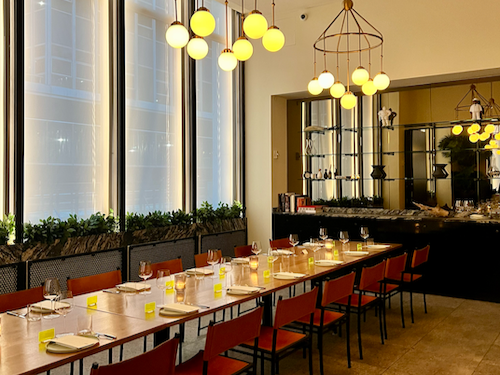After a year and a half of all-virtual-all-the-time, in-person events are starting to make their way onto our fall calendars.
As we begin to plan and attend events again, the top concern on event managers’ minds is how to be certain that these events occur—our events team has compiled 5 strategies to assure your event can happen safely.
Keep it Small
It’s safe to err on the more intimate side of audience size if you are nervous about hosting your first event of the 2020s. Large trade shows and meetings of ten thousand or more individuals may take a bit more time to exit the virtual world, let alone be completely averse to cancellation. Planning smaller events that curate a local audience—versus a global audience that might need to fly in—is one way to make sure your event occurs, while keeping attendees safe. Thinking small also means thinking proportionally for your venue. Renting more space for fewer people is one way to guarantee that everyone has the ability to social distance, if needed.Choose Outdoor Venues
One way to feel both safe and creative while hosting your event is to opt for a unique venue. Outdoor locations including rooftops, gardens, patios, or outdoor tents make for a safe and fun attendee experience. An outdoor venue can quite literally be the perfect breath of fresh air—all while making your audience feel safer than being inside a conference hall with no ventilation.
If your venue is outside, it is also much less likely to be cancelled by the city or other types of governing bodies, should another phase of new COVID regulations occur.Put Safety First
Guest check-in may look different this year. When a guest arrives, checking vaccination cards or having onsite testing adds an additional level of safety to your event. Temperature or symptom checks at the door are another way to guarantee guests that their health is a priority. High-traffic event areas should have hand sanitizer stations and tables with extra masks to assure that attendees with varying in-person comfort levels are accommodated for.
You may hear new terms like “MERV numbers.” A MERV number is reflective of your venue’s air filtration system. If your venue does not have a MERV number of 13 or higher, you may want to consider bringing in additional air filters to make certain your event is as safe as possible.Limit Touch
Remember the days of printed materials, lanyards, and onsite swag? The shift to digital for event agendas, maps, and other paper items limits the number of touchpoints for your attendees, while also making your event more eco-friendly (we love a win-win!).
An alternate strategy—should you still want some element of swag—is to send items to attendees and speakers prior to the event. This cuts down on the number of items that attendees are in direct contact with at your venue, which is especially important for areas that are already highly trafficked.Rethink Food
Buffets are so 2019! Individually packaged meal items ensure that attendees’ food has limited contact with others. Using boxed lunches or plated meals is the best way to affirm your attendees are safe. Handing out $10-$20 gift cards to restaurants around the venue is another outside-of-the-box solution, so that attendees can have more control over their choices. It's another win-win, contributing to local businesses around you!
We are all thrilled about in-person events coming back to life in 2021! However, the reality is that we are in a new normal and it is crucial to consider the safest, most responsible strategies. Follow these tips and tricks to give your event the best chance to happen this year, as safely as possible. And, if you’d like help planning your next event, get in touch!




